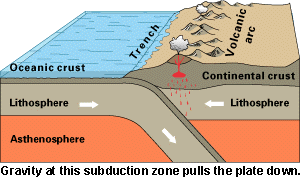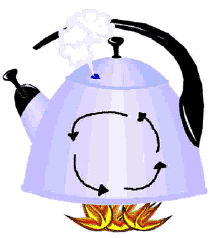BACKGROUND:
Understanding the movement and behavior of the Earth's
outermost layers has been a painstakingly long scientific process. The
theory of plate tectonics is our current "best explanation" and
working model for answering these questions. Plate tectonic theory has
developed slowly and progressively since it was developed in the 1960s. It
is a theory that truly has the entire world as its experiment.
According to the theory of plate tectonics, the
Earth's crust and upper mantle are broken into moving plates of
"lithosphere." The lithospheric plates are solid rock. There are
several very large plates, each consisting of both oceanic and continental
portions. There are a dozen or more smaller plates. The plates average about
80 kilometers (50 miles) in thickness.
All of the plates are moving. They are slow, moving at
speeds of centimeters to tens of centimeters per year. They slide along on
top of an underlying mantle layer called the asthenosphere, which contains a
little magma (molten rock). Many types of evidence indicate that the plates
move.
 Many
lines of evidence indicate that the plates are moving. What is less clear,
however, is why the plates move. There are two main scientific ideas for
explaining plate movement: gravity and convection currents. All objects on
and in the Earth are pulled towards its center by the force of gravity. This
may affect the plates at converging plate boundaries in areas called
subduction zones, where one plate sinks into the mantle. Some evidence
suggests that gravity pulls the sinking plate down. The rest of the plate is
dragged along behind it. This is physically similar to slowly pushing a
piece of paper off a table; it eventually bends, and
Many
lines of evidence indicate that the plates are moving. What is less clear,
however, is why the plates move. There are two main scientific ideas for
explaining plate movement: gravity and convection currents. All objects on
and in the Earth are pulled towards its center by the force of gravity. This
may affect the plates at converging plate boundaries in areas called
subduction zones, where one plate sinks into the mantle. Some evidence
suggests that gravity pulls the sinking plate down. The rest of the plate is
dragged along behind it. This is physically similar to slowly pushing a
piece of paper off a table; it eventually bends, and  slides
off, pulling the rest of the paper behind it. The other reason for plate
motion relates to convection currents within the upper part of the mantle.
Convection is the heat-driven circulation of a fluid. In the mantle, heat
from deeper in the Earth causes the overlying mantle to circulate. The
mantle can circulate because it contains a little magma (molten rock); it
behaves like a very hot mush. Mantle convection currents move very, very,
slowly. It is possible that as the mantle convects, it drags the overlying
plates along with it. It is likely that both convection and gravity
contribute to the movement of the plates.
slides
off, pulling the rest of the paper behind it. The other reason for plate
motion relates to convection currents within the upper part of the mantle.
Convection is the heat-driven circulation of a fluid. In the mantle, heat
from deeper in the Earth causes the overlying mantle to circulate. The
mantle can circulate because it contains a little magma (molten rock); it
behaves like a very hot mush. Mantle convection currents move very, very,
slowly. It is possible that as the mantle convects, it drags the overlying
plates along with it. It is likely that both convection and gravity
contribute to the movement of the plates.
This unit introduces the importance of convection
currents into the overall concept of plate tectonics. Convection currents
are common in everyday life. Water that is put over a hot stove heats by
convection. The water closest to the heat source becomes less dense and
rises. The water that is cooler and on top will sink to the bottom. This
sinking of the denser fluid and rising of the less dense fluid causes
movement in a circular motion as shown in the diagram below; this is
convection.
PROCEDURE:
-
Explain the physical basis of convection currents to the students.
Explain that it may be a force responsible for moving the plates.
You may wish to demonstrate convection to the class with a glass pan,
water, and a hot plate. Another way to demonstrate this is to get a
ladder and have the students take turns "feeling" the
temperature of the air near the floor of the room, then near the
ceiling. It is warmer near the ceiling because warm, buoyant air rises,
just like warm buoyant rock rises inside the Earth.
-
Draw the diagram on the board. Ask the students in which room the air
will circulate by convection currents. Emphasize that in room A, the
difference in temperature caused by the candle will help circulate the
air by convection. Ask the students in which directions they air will
circulate. Warm air will rise, cool down and move to the left. When the
air cools it will then descend.